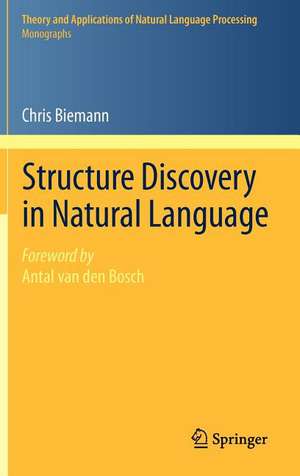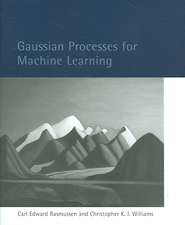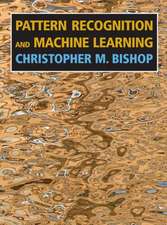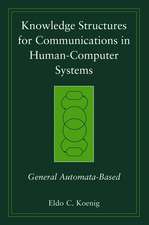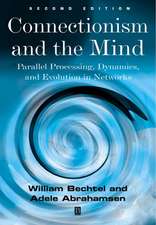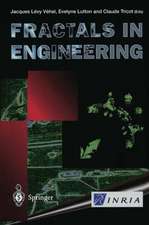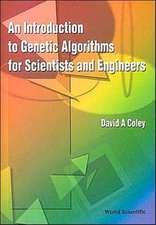Structure Discovery in Natural Language: Theory and Applications of Natural Language Processing
Autor Chris Biemann Cuvânt înainte de Antal van den Boschen Limba Engleză Hardback – 9 dec 2011
This book sets an ambitious goal: to shift the development of language processing systems to a much more automated setting than previous works. A new approach is defined: what if computers analysed large samples of language data on their own, identifying structural regularities that perform the necessary abstractions and generalisations in order to better understand language in the process?
After defining the framework of Structure Discovery and shedding light on the nature and the graphic structure of natural language data, several procedures are described that do exactly this: let the computer discover structures without supervision in order to boost the performance of language technology applications. Here, multilingual documents are sorted by language, word classes are identified, and semantic ambiguities are discovered and resolved without using a dictionary or other explicit human input. The book concludes with an outlook on the possibilities implied by this paradigm and sets the methods in perspective to human computer interaction.
The target audience are academics on all levels (undergraduate and graduate students, lecturers and professors) working in the fields of natural language processing and computational linguistics, as well as natural language engineers who are seeking to improve their systems.
| Toate formatele și edițiile | Preț | Express |
|---|---|---|
| Paperback (1) | 641.87 lei 6-8 săpt. | |
| Springer Berlin, Heidelberg – mar 2014 | 641.87 lei 6-8 săpt. | |
| Hardback (1) | 644.81 lei 6-8 săpt. | |
| Springer Berlin, Heidelberg – 9 dec 2011 | 644.81 lei 6-8 săpt. |
Din seria Theory and Applications of Natural Language Processing
- 15%
 Preț: 651.19 lei
Preț: 651.19 lei - 20%
 Preț: 581.04 lei
Preț: 581.04 lei - 20%
 Preț: 637.23 lei
Preț: 637.23 lei - 20%
 Preț: 644.33 lei
Preț: 644.33 lei - 20%
 Preț: 641.87 lei
Preț: 641.87 lei - 20%
 Preț: 645.65 lei
Preț: 645.65 lei - 20%
 Preț: 643.97 lei
Preț: 643.97 lei - 20%
 Preț: 334.71 lei
Preț: 334.71 lei - 20%
 Preț: 334.38 lei
Preț: 334.38 lei -
 Preț: 428.96 lei
Preț: 428.96 lei - 20%
 Preț: 332.57 lei
Preț: 332.57 lei - 15%
 Preț: 645.60 lei
Preț: 645.60 lei - 20%
 Preț: 649.28 lei
Preț: 649.28 lei - 20%
 Preț: 716.23 lei
Preț: 716.23 lei - 20%
 Preț: 763.26 lei
Preț: 763.26 lei - 20%
 Preț: 818.54 lei
Preț: 818.54 lei - 20%
 Preț: 1004.48 lei
Preț: 1004.48 lei - 20%
 Preț: 938.18 lei
Preț: 938.18 lei
Preț: 644.81 lei
Preț vechi: 806.01 lei
-20% Nou
Puncte Express: 967
Preț estimativ în valută:
123.39€ • 131.94$ • 102.88£
123.39€ • 131.94$ • 102.88£
Carte tipărită la comandă
Livrare economică 17 aprilie-01 mai
Preluare comenzi: 021 569.72.76
Specificații
ISBN-13: 9783642259227
ISBN-10: 3642259227
Pagini: 196
Ilustrații: XX, 180 p.
Dimensiuni: 155 x 235 x 23 mm
Greutate: 0.4 kg
Ediția:2012
Editura: Springer Berlin, Heidelberg
Colecția Springer
Seria Theory and Applications of Natural Language Processing
Locul publicării:Berlin, Heidelberg, Germany
ISBN-10: 3642259227
Pagini: 196
Ilustrații: XX, 180 p.
Dimensiuni: 155 x 235 x 23 mm
Greutate: 0.4 kg
Ediția:2012
Editura: Springer Berlin, Heidelberg
Colecția Springer
Seria Theory and Applications of Natural Language Processing
Locul publicării:Berlin, Heidelberg, Germany
Public țintă
GraduateCuprins
Foreword by Antal van den Bosch.- 1.Introduction.- 2.Graph Models.- 3.SmallWorlds of Natural Language.- 4.Graph Clustering.- 5.Unsupervised Language Separation .- 6.Unsupervised Part-of-Speech Tagging.- 7.Word Sense Induction and Disambiguation.- 8.Conclusion.- References.
Textul de pe ultima copertă
Current language technology is dominated by approaches that either enumerate a large set of rules, or are focused on a large amount of manually labelled data. The creation of both is time-consuming and expensive, which is commonly thought to be the reason why automated natural language understanding has still not made its way into “real-life” applications yet.
This book sets an ambitious goal: to shift the development of language processing systems to a much more automated setting than previous works. A new approach is defined: what if computers analysed large samples of language data on their own, identifying structural regularities that perform the necessary abstractions and generalisations in order to better understand language in the process?
After defining the framework of Structure Discovery and shedding light on the nature and the graphic structure of natural language data, several procedures are described that do exactly this: let the computer discover structures without supervision in order to boost the performance of language technology applications. Here, multilingual documents are sorted by language, word classes are identified, and semantic ambiguities are discovered and resolved without using a dictionary or other explicit human input. The book concludes with an outlook on the possibilities implied by this paradigm and sets the methods in perspective to human computer interaction.
The target audience are academics on all levels (undergraduate and graduate students, lecturers and professors) working in the fields of natural language processing and computational linguistics, as well as natural language engineers who are seeking to improve their systems.
This book sets an ambitious goal: to shift the development of language processing systems to a much more automated setting than previous works. A new approach is defined: what if computers analysed large samples of language data on their own, identifying structural regularities that perform the necessary abstractions and generalisations in order to better understand language in the process?
After defining the framework of Structure Discovery and shedding light on the nature and the graphic structure of natural language data, several procedures are described that do exactly this: let the computer discover structures without supervision in order to boost the performance of language technology applications. Here, multilingual documents are sorted by language, word classes are identified, and semantic ambiguities are discovered and resolved without using a dictionary or other explicit human input. The book concludes with an outlook on the possibilities implied by this paradigm and sets the methods in perspective to human computer interaction.
The target audience are academics on all levels (undergraduate and graduate students, lecturers and professors) working in the fields of natural language processing and computational linguistics, as well as natural language engineers who are seeking to improve their systems.
Caracteristici
The book sets an ambitious goal: to shift development of language processing systems to a much more automated setting than previous works A new approach is defined All software described is open source and freely available ? Includes supplementary material: sn.pub/extras
